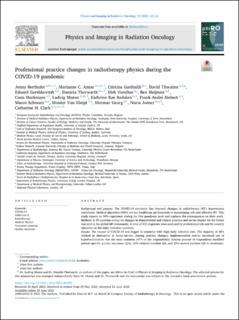| dc.contributor.author | Bertholet, Jenny | |
| dc.contributor.author | Aznar, Marianne C. | |
| dc.contributor.author | Garibaldi, Cristina | |
| dc.contributor.author | Thwaites, David | |
| dc.contributor.author | Gershkevitsh, Eduard | |
| dc.contributor.author | Thorwarth, Daniela | |
| dc.contributor.author | Verellen, Dirk | |
| dc.contributor.author | Heijmen, Ben | |
| dc.contributor.author | Hurkmans, Coen | |
| dc.contributor.author | Muren, Ludvig | |
| dc.contributor.author | Redalen, Kathrine Røe | |
| dc.contributor.author | Siebert, Frank-André | |
| dc.contributor.author | Schwarz, Marco | |
| dc.contributor.author | Van Elmpt, Wouter | |
| dc.contributor.author | Georg, Dietmar | |
| dc.contributor.author | Jornet, Nuria | |
| dc.contributor.author | Clark, Catharine H. | |
| dc.date.accessioned | 2023-01-13T13:27:40Z | |
| dc.date.available | 2023-01-13T13:27:40Z | |
| dc.date.created | 2021-12-10T12:20:20Z | |
| dc.date.issued | 2021 | |
| dc.identifier.citation | Physics and imaging in radiation oncology (PIRO). 2021, 19 25-32. | en_US |
| dc.identifier.issn | 2405-6316 | |
| dc.identifier.uri | https://hdl.handle.net/11250/3043410 | |
| dc.description.abstract | Background and purpose
The COVID-19 pandemic has imposed changes in radiotherapy (RT) departments worldwide. Medical physicists (MPs) are key healthcare professionals in maintaining safe and effective RT. This study reports on MPs experience during the first pandemic peak and explores the consequences on their work.
Methods
A 39-question survey on changes in departmental and clinical practice and on the impact for the future was sent to the global MP community. A total of 433 responses were analysed by professional role and by country clustered on the daily infection numbers.
Results
The impact of COVID-19 was bigger in countries with high daily infection rate. The majority of MPs worked in alternation at home/on-site. Among practice changes, implementation and/or increased use of hypofractionation was the most common (47% of the respondents). Sixteen percent of respondents modified patient-specific quality assurance (QA), 21% reduced machine QA, and 25% moved machine QA to weekends/evenings. The perception of trust in leadership and team unity was reversed between management MPs (towards increased trust and unity) and clinical MPs (towards a decrease). Changes such as home-working and increased use of hypofractionation were welcomed. However, some MPs were concerned about pressure to keep negative changes (e.g. weekend work).
Conclusion
COVID-19 affected MPs through changes in practice and QA procedures but also in terms of trust in leadership and team unity. Some changes were welcomed but others caused worries for the future. This report forms the basis, from a medical physics perspective, to evaluate long-lasting changes within a multi-disciplinary setting. | en_US |
| dc.language.iso | eng | en_US |
| dc.publisher | Elsevier | en_US |
| dc.rights | Navngivelse 4.0 Internasjonal | * |
| dc.rights.uri | http://creativecommons.org/licenses/by/4.0/deed.no | * |
| dc.title | Professional practice changes in radiotherapy physics during the COVID-19 pandemic | en_US |
| dc.title.alternative | Professional practice changes in radiotherapy physics during the COVID-19 pandemic | en_US |
| dc.type | Peer reviewed | en_US |
| dc.type | Journal article | en_US |
| dc.description.version | publishedVersion | en_US |
| dc.source.pagenumber | 25-32 | en_US |
| dc.source.volume | 19 | en_US |
| dc.source.journal | Physics and imaging in radiation oncology (PIRO) | en_US |
| dc.identifier.doi | 10.1016/j.phro.2021.06.002 | |
| dc.identifier.cristin | 1967042 | |
| cristin.ispublished | true | |
| cristin.fulltext | original | |
| cristin.qualitycode | 1 | |

